Enabling Virtual AAA Management in SDN-Based IoT Networks †
Abstract
:1. Introduction
2. Related Work
3. Security Management Framework and Proposal Overview
3.1. ANASTACIA Framework Overview
3.2. Solution Overview
4. vAAA in SDN/NFV Enabled IoT Networks
4.1. AAA Preliminaries
4.2. Policy-Based AAA Management
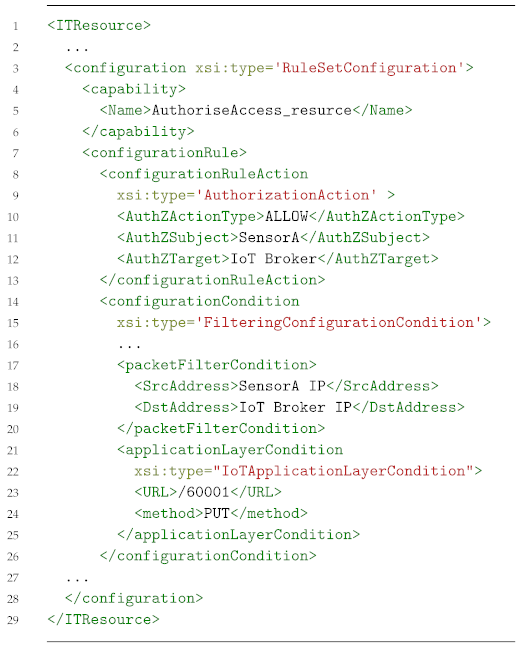
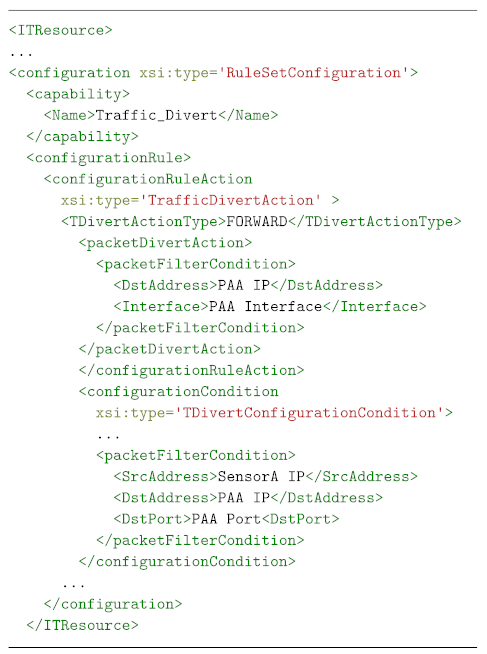
4.3. IoT Bootstrapping
4.4. IoT Device Authorization
5. Channel Protection in Softwarized IoT Networks
5.1. Channel Protection
5.2. Policy-Based DTLS Management in SDN Networks
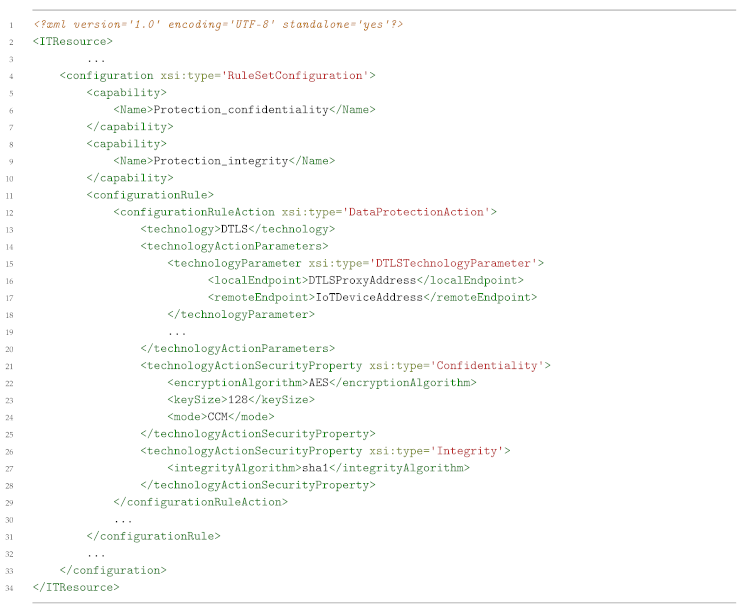
5.3. IoT Channel Protection and Key Distribution
6. Proposal Evaluation
6.1. Smart Building Use Case
- The Policy Interpreter, Policy Repository, Security Enabler Provider and Security Orchestrator are virtualized and dockerized in an Intel(R) Core(TM) i7-2600 CPU at 3.4 GHz, using three vCores, 3.5 GB of RAM and 30 GB of HDD.
- The IoT Controller is virtualized and dockerized in an Intel Core Processor at 1.5 GHz using 2vCores, 2 GB of RAM and 15 GB of HDD.
- The PAA Network Authenticator, Capability manager, AAA Server, PDP and IoT broker are virtualized and dockerized in an Intel(R) Xeon(R) CPU E5-2603, v3 @ 1.60 GHz with 12 cores and 32 GB RAM and SATA 10k in mode RAID 1 disk drives.
- The SDN Controller is ONOS version 1.15.0.9e4972c5 which has been virtualized and dockerized in an Intel Core Processor (Haswell) at 1.5 GHz using two vCores, 4 GB of RAM and 15 GB of HDD. Control plane is assumed to be isolated from data plane, in this case by means of VLANs.
- The SDN Switch is an HP model 2920, software revision WB.16.04.0008, ROM version WB.16.03.
- The IoT devices are MSP430F5419A-EP at 25 Mhz, 128 KB ROM and 16 KB RAM, running a customized version of Contiki OS 2.7 and erbium CoAP server.
- The 6lowPAN bridge is a MSP430F5419A-EP at 25 Mhz, 128 KB ROM and 16 KB RAM, running a customized version of Contiki OS 2.7 in order to allow the communication between 802.15.4 and 802.3.
- The PANA authentication software is based on PANATIKI (https://sourceforge.net/projects/panatiki/) implementation for the IoT device, and a modified version of the OpenPANA implementation (https://sourceforge.net/projects/openpana/) for the PAA.
- The distributed authorization token is based on an implementation of the Capability Token [34].
- For the DTLS communication, tinyDTLS (https://sourceforge.net/projects/tinydtls/) is used within the IoT device while Californium (https://github.com/eclipse/californium) is employed within the DTLS proxy in charge of enable the DTLS communication and decrypt the IoT egressed DTLS/CoAP messages to the CoAP required by the IoT broker to publish information.
- PDP, DTLS Proxy and IoT Controller plugins have been implemented from scratch in python.
- AAA policy refinement and translation, IoT registration, IoT Controller, Key management and PDP APIs have been implemented from scratch in python.
- All the elements in the experiment have NTP synchronized avoiding false negative cases due to clock mismatch with the capability Token.
6.2. Performance Evaluation
7. Conclusions
Author Contributions
Funding
Conflicts of Interest
References
- Vaquero, L.M.; Rodero-Merino, L. Finding Your Way in the Fog: Towards a Comprehensive Definition of Fog Computing. SIGCOMM Comput. Commun. Rev. 2014, 44, 27–32. [Google Scholar] [CrossRef]
- Azimi, I.; Anzanpour, A.; Rahmani, A.M.; Pahikkala, T.; Levorato, M.; Liljeberg, P.; Dutt, N. HiCH: Hierarchical Fog-Assisted Computing Architecture for Healthcare IoT. ACM Trans. Embed. Comput. Syst. 2017, 16, 174. [Google Scholar] [CrossRef]
- Herrera, J.G.; Botero, J.F. Resource Allocation in NFV: A Comprehensive Survey. IEEE Trans. Netw. Serv. Manag. 2016, 13, 518–532. [Google Scholar] [CrossRef]
- Vaquero, L.M.; Cuadrado, F.; Elkhatib, Y.; Bernal-Bernabe, J.; Srirama, S.N.; Zhani, M.F. Research challenges in nextgen service orchestration. Future Gener. Comput. Syst. 2019, 90, 20–38. [Google Scholar] [CrossRef]
- Bernabé, J.B.; Pérez, J.M.M.; Calero, J.M.A.; Re, J.D.J.; Clemente, F.J.; Pérez, G.M.; Skarmeta, A.F. Security Policy Specification. In Network and Traffic Engineering in Emerging Distributed Computing Applications; IGI Global: Hershey, PA, USA, 2013; pp. 66–93. [Google Scholar]
- DESEREC Project: DEpendability and Security by Enhanced REConfigurability. Available online: http://www.deserec.eu/ (accessed on 11 January 2019).
- Basile, C. Policy Transformation and Optimization Techniques. Available online: https://www.secured-fp7.eu/files/secured_d42_policy_refinement_v0103.pdf (accessed on 11 January 2019).
- Kolluru, K.K.; Paniagua, C.; van Deventer, J.; Eliasson, J.; Delsing, J.; Delong, R. An AAA solution for securing industrial IoT devices using next generation access control. In Proceedings of the IEEE Industrial Cyber-Physical Systems (ICPS), St. Petersburg, Russia, 15–18 May 2018; pp. 737–742. [Google Scholar] [CrossRef]
- Zarca, A.M.; Garcia-Carrillo, D.; Bernabe, J.B.; Ortiz, J.; Marin-Perez, R.; Skarmeta, A. Managing AAA in NFV/SDN-enabled IoT scenarios. In Proceedings of the 2018 Global Internet of Things Summit (GIoTS), Bilbao, Spain, 4–7 June 2018; pp. 1–7. [Google Scholar] [CrossRef]
- Franke, U.; Brynielsson, J. Cyber situational awareness—A systematic review of the literature. Comput. Secur. 2014, 46, 18–31. [Google Scholar] [CrossRef]
- Liu, A.; Zhao, S. High-performance target tracking scheme with low prediction precision requirement in WSNs. Int. J. Ad Hoc Ubiquit. Comput. 2018, 29, 270. [Google Scholar] [CrossRef]
- Garcia-Carrillo, D.; Marin-Lopez, R. Lightweight CoAP-Based Bootstrapping Service for the Internet of Things. Sensors 2016, 16. [Google Scholar] [CrossRef] [PubMed]
- ZigBee Alliance. ZigBee IP Specification; ZigBee document 095023r34; ZigBee Alliance: Davis, CA, USA, 2014. [Google Scholar]
- Selander, G.; Mattsson, J.; Palombini, F.; Seitz, L. Object Security for Constrained RESTful Environments (OSCORE); Work in Progress; Internet Engineering Task Force: Fremont, CA, USA, 2018. [Google Scholar]
- Selander, G.; Mattsson, J.; Palombini, F. Ephemeral Diffie-Hellman Over COSE (EDHOC); Internet-Draft draft-selander-ace-cose-ecdhe-07; Work in Progress; Internet Engineering Task Force: Fremont, CA, USA, 2017. [Google Scholar]
- Scott-Hayward, S.; O’Callaghan, G.; Sezer, S. Sdn Security: A Survey. In Proceedings of the 2013 IEEE SDN for Future Networks and Services (SDN4FNS), Trento, Italy, 11–13 November 2013; pp. 1–7. [Google Scholar] [CrossRef]
- Lopez, R.; Lopez-Millan, G. Software-Defined Networking (SDN)-Based IPsec Flow Protection; Internet-Draft draft-ietf-i2nsf-sdn-ipsec-flow-protection-03; Work in Progress; Internet Engineering Task Force: Fremont, CA, USA, 2018. [Google Scholar]
- Farris, I.; Taleb, T.; Khettab, Y.; Song, J.S. A survey on emerging SDN and NFV security mechanisms for IoT systems. IEEE Commun. Surv. Tutor. 2018. [Google Scholar] [CrossRef]
- Li, Y.; Chen, M. Software-Defined Network Function Virtualization: A Survey. IEEE Access 2015, 3, 2542–2553. [Google Scholar] [CrossRef]
- Salva-Garcia, P.; Alcaraz-Calero, J.M.; Wang, Q.; Bernabe, J.B.; Skarmeta, A. 5G NB-IoT: Efficient Network Traffic Filtering for Multitenant IoT Cellular Networks. Secur. Commun. Netw. 2018, 2018. [Google Scholar] [CrossRef]
- Basile, C.; Lioy, A.; Pitscheider, C.; Valenza, F.; Vallini, M. A novel approach for integrating security policy enforcement with dynamic network virtualization. In Proceedings of the 1st IEEE Conference on Network Softwarization (NetSoft), London, UK, 13–17 April 2015; pp. 1–5. [Google Scholar]
- Molina Zarca, A.; Bernal Bernabe, J.; Farris, I.; Khettab, Y.; Taleb, T.; Skarmeta, A. Enhancing IoT security through network softwarization and virtual security appliances. Int. J. Netw. Manag. 2018, 28, e2038. [Google Scholar] [CrossRef]
- ANASTACIA. Advanced Networked Agents for Security and Trust Assessment in CPS/IoT Architectures. Available online: http://www.anastacia-h2020.eu/ (accessed on 11 January 2019).
- Ziegler, S.; Skarmeta, A.; Bernal, J.; Kim, E.; Bianchi, S. ANASTACIA: Advanced networked agents for security and trust assessment in CPS IoT architectures. In Proceedings of the 2017 Global Internet of Things Summit (GIoTS), Geneva, Switzerland, 6–9 June 2017; pp. 1–6. [Google Scholar] [CrossRef]
- Farris, I.; Bernabe, J.; Toumi, N.; Garcia-Carrillo, D.; Taleb, T.; Skarmeta, A.; Sahlin, B. Towards Provisioning of SDN/NFV-based Security Enablers for Integrated Protection of IoT Systems. In Proceedings of the IEEE Conference on Standards for Communications and Networking (CSCN-2017), Helsinki, Finland, 18–20 September 2017. [Google Scholar]
- ANASTACIA. D1.2 User Centred Requirements Initial Analysis. Available online: http://anastacia-h2020.eu/deliverables/ANASTACIA-WP1-T1.2-SOFT-D1.2-UserCentredRequirementsInitialAnalysis-v11.pdf (accessed on 11 January 2019).
- ANASTACIA. D2.2 Attack Threats Analysis and Contingency Actions—Initial Report. Available online: http://anastacia-h2020.eu/deliverables/ANASTACIA-WP2-T2.2-CNR-D2.2-AttackThreatsAnalysisAndContingencyActionsInitialReport-v0.5.pdf (accessed on 11 January 2019).
- ANASTACIA. D2.3 Privacy Risk Modelling and Contingency—Initial Report. Available online: http://anastacia-h2020.eu/deliverables/ANASTACIA-WP2-T2.3-MAND-D2.3-PrivacyRiskModellingAndContingencyInitialReport-v1.0.pdf (accessed on 11 January 2019).
- Rigney, C.; Willens, S.; Rubens, A.; Simpson, W. Remote Authentication Dial In User Service (RADIUS). RFC 2865 (Draft Standard), 2000; ISSN 2070-1721. Updated by RFCs 2868, 3575, 5080, 6929. Available online: https://tools.ietf.org/html/rfc2865 (accessed on 11 January 2019).
- Fajardo, V.; Arkko, J.; Loughney, J.; Zorn, G. Diameter Base Protocol. RFC 6733 (Proposed Standard), 2012; ISSN 2070-1721. Updated by RFC 7075. Available online: https://tools.ietf.org/html/rfc6733 (accessed on 11 January 2019).
- Aboba, B.; Simon, D.; Eronen, P. Extensible Authentication Protocol (EAP) Key Management Framework. RFC 5247 (Proposed Standard), 2008; ISSN 2070-1721. Available online: https://tools.ietf.org/html/rfc5247 (accessed on 11 January 2019).
- Forsberg, D.; Ohba, Y.; Patil, B.; Tschofenig, H.; Yegin, A. Protocol for Carrying Authentication for Network Access (PANA). RFC 5191 (Proposed Standard), 2008; ISSN 2070-1721. Updated by RFC 5872. Available online: https://tools.ietf.org/html/rfc5191 (accessed on 11 January 2019).
- Garcia-Carrillo, D.; Marin-Lopez, R.; Kandasamy, A.; Pelov, A. A CoAP-Based Network Access Authentication Service for Low-Power Wide Area Networks: LO-CoAP-EAP. Sensors 2017, 17, 1424–8220. [Google Scholar] [CrossRef] [PubMed]
- Hernandez-Ramos, J.L.; Jara, A.J.; Marin, L.; Skarmeta, A. Distributed capability-based access control for the internet of things. J. Internet Serv. Inf. Secur. (JISIS) 2013, 3, 1–16. [Google Scholar]
- Liu, X.; Liu, W.; Liu, Y.; Song, H.; Liu, A.; Liu, X. A Trust and Priority Based Code Updated Approach to Guarantee Security for Vehicles Network. IEEE Access 2018, 6, 55780–55796. [Google Scholar] [CrossRef]
- Bernal Bernabe, J.; Hernandez Ramos, J.L.; Skarmeta Gomez, A.F. TACIoT: multidimensional trust-aware access control system for the Internet of Things. Soft Comput. 2016, 20, 1763–1779. [Google Scholar] [CrossRef]
- Shelby, Z.; Hartke, K.; Bormann, C. The Constrained Application Protocol (CoAP). RFC 7252, 2014. Available online: https://tools.ietf.org/html/rfc7252 (accessed on 11 January 2019).
- Ohba, Y.; Yegin, A. Definition of Master Key Between Pana Client and Enforcement Point. RFC 5807 (Proposed Standard). 2010. Available online: https://tools.ietf.org/html/rfc5807 (accessed on 11 January 2019).
- Kivinen, T.; Hoffman, P.; Kaufman, C.; Nir, Y.; Eronen, P. Internet Key Exchange Protocol Version 2 (IKEv2). RFC 7296 (Proposed Standard). 2014. Available online: https://tools.ietf.org/html/rfc7296 (accessed on 11 January 2019).
- Mehta, D.; Mady, A.E.D.; Boubekeur, M.; Shila, D.M. Anomaly-Based Intrusion Detection System for Embedded Devices on Internet. In Proceedings of the Tenth International Conference on Advances in Circuits, Electronics and Micro-electronics, Venice, Italy, 16–20 September 2018. [Google Scholar]
- Osterlind, F.; Dunkels, A.; Eriksson, J.; Finne, N.; Voigt, T. Cross-Level Sensor Network Simulation with COOJA. In Proceedings of the 2006 31st IEEE Conference on Local Computer Networks, Tampa, FL, USA, 14–16 November 2006; pp. 641–648. [Google Scholar] [CrossRef]
- Hernandez-Ramos, J.L.; Carrillo, D.G.; Marín-López, R.; Skarmeta, A.F. Dynamic security credentials PANA-based provisioning for IoT smart objects. In Proceedings of the 2015 IEEE 2nd World Forum on Internet of Things (WF-IoT), Milan, Italy, 14–16 December 2015; pp. 783–788. [Google Scholar] [CrossRef]
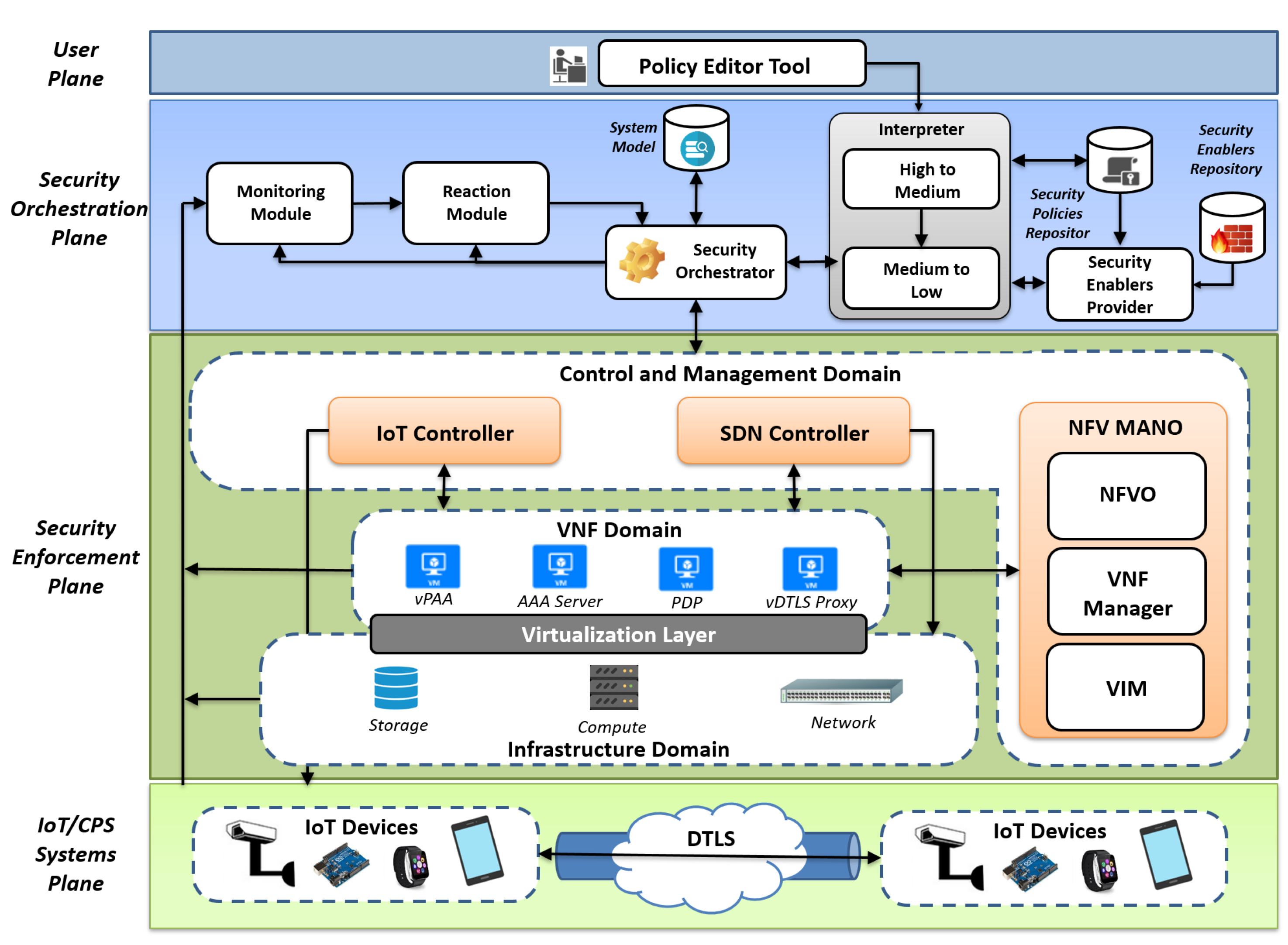
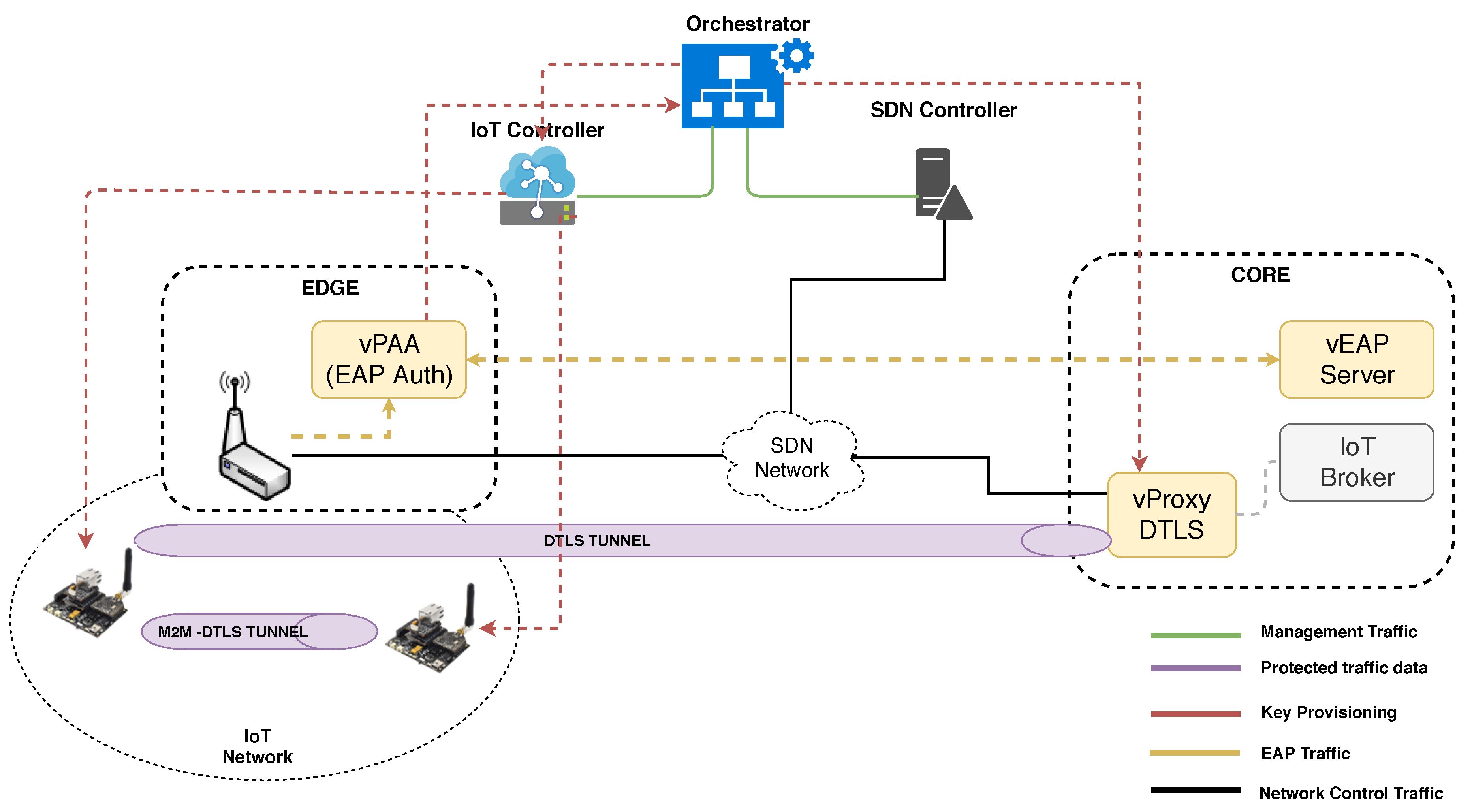
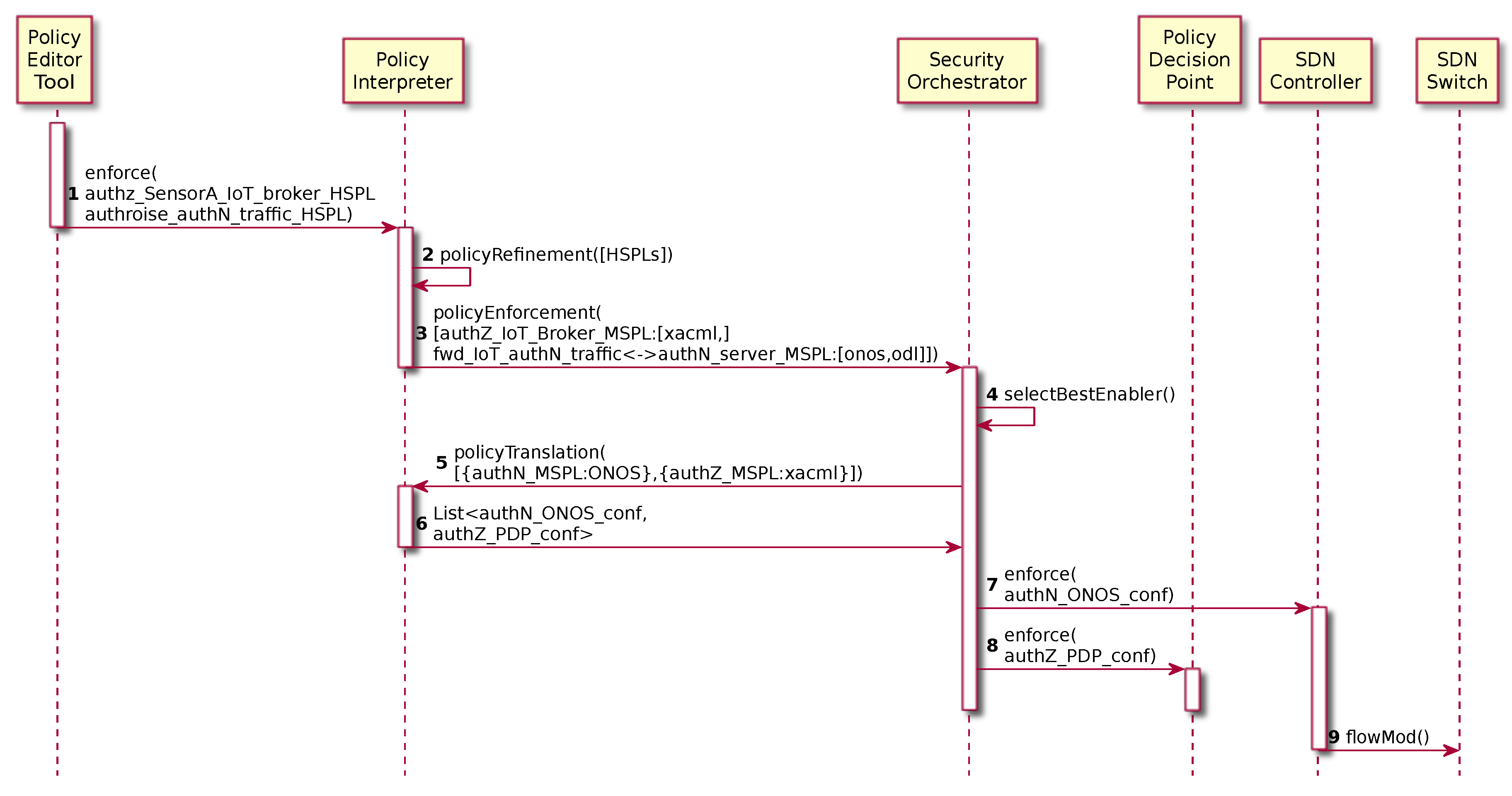
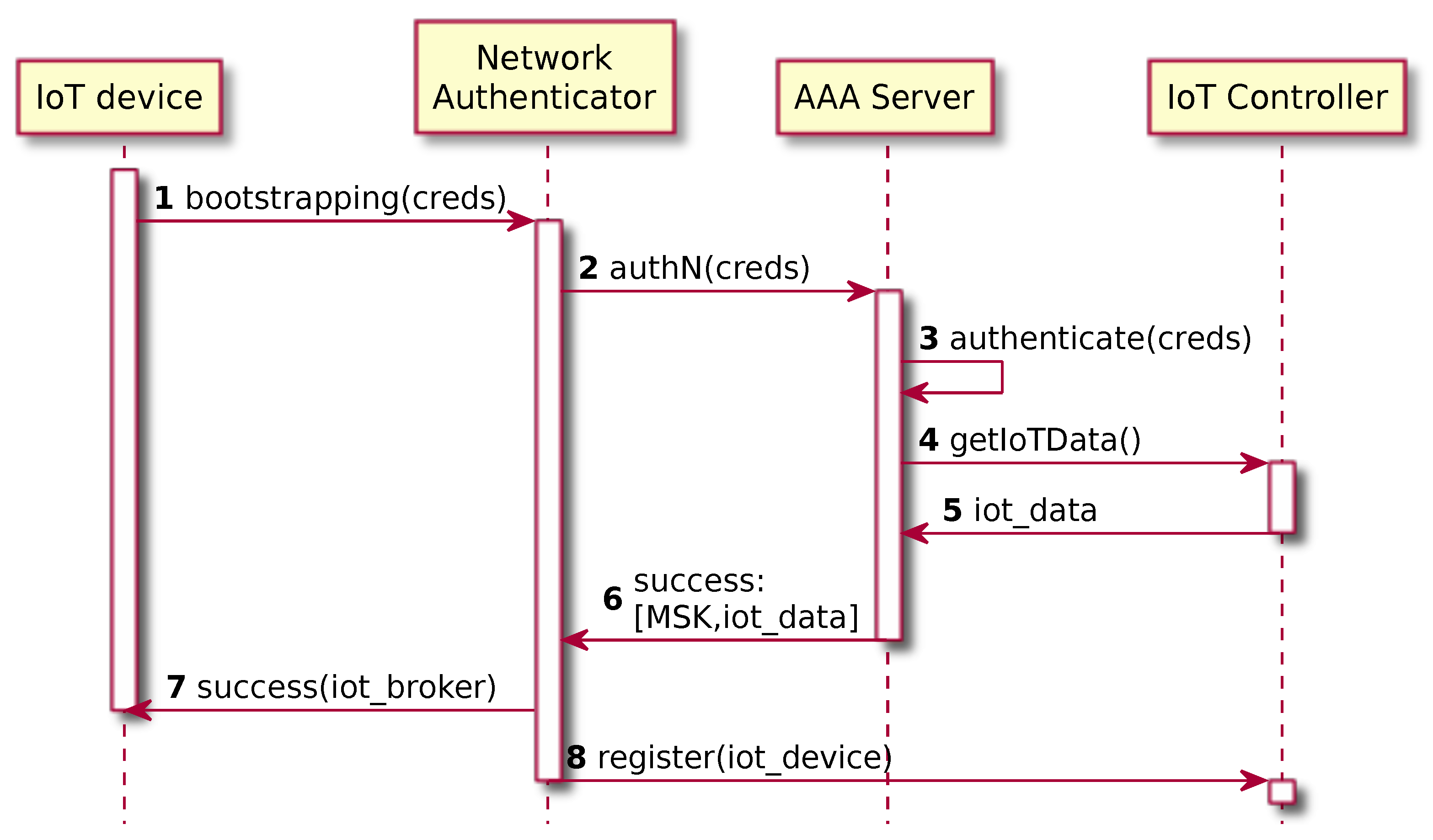
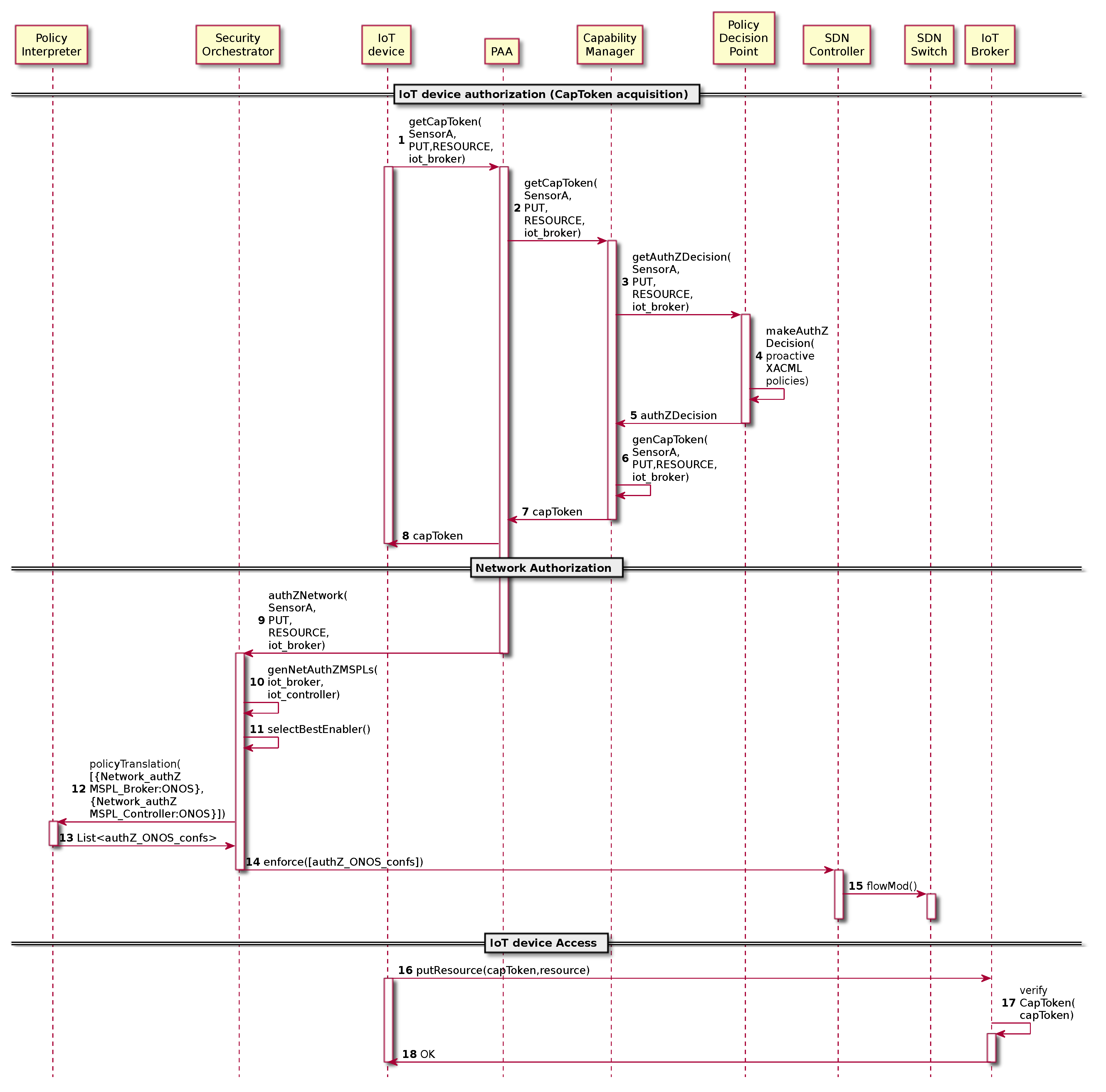
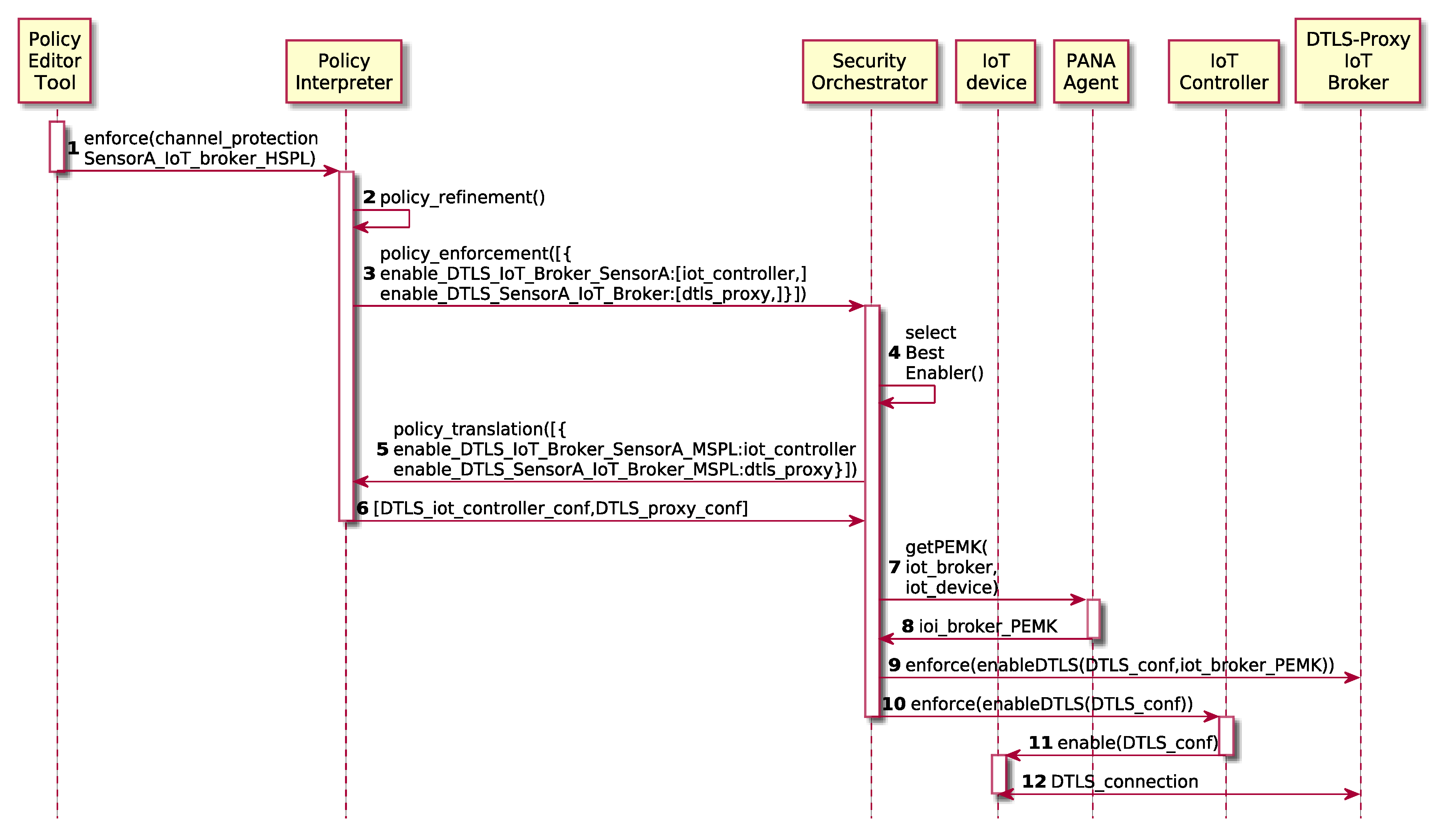
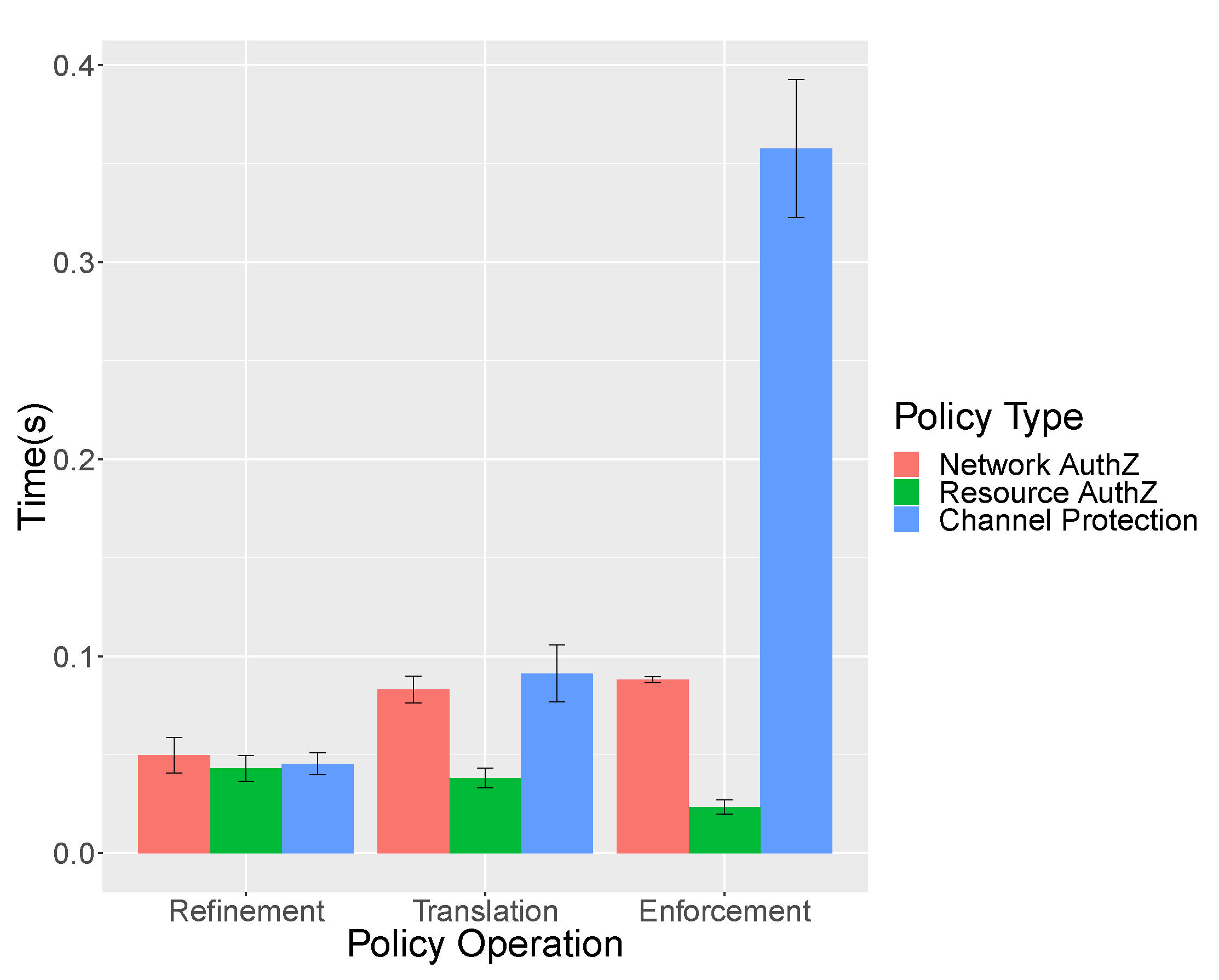
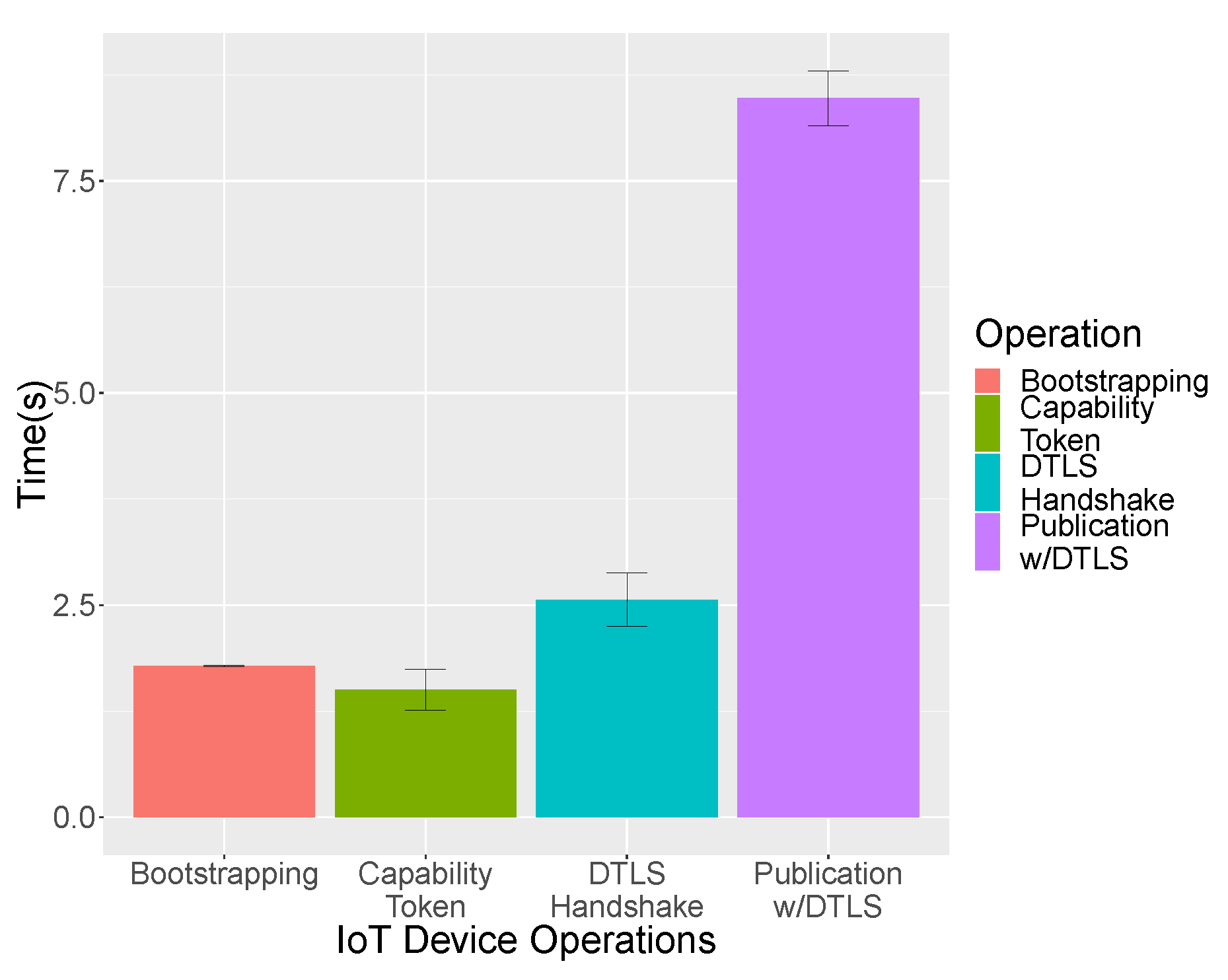
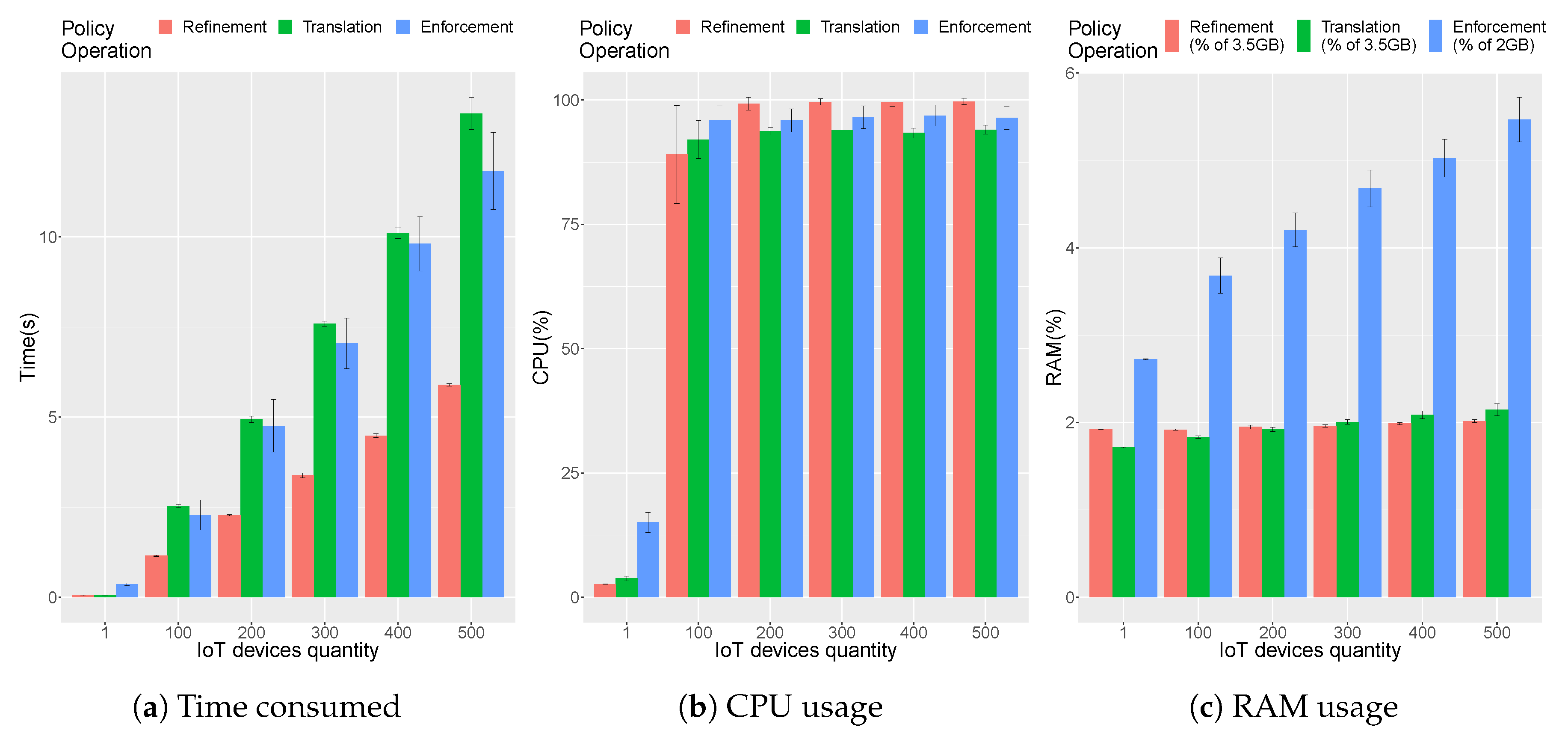
| IoT Device Operation | Message Count | Total Bytes | s | s |
|---|---|---|---|---|
| Bootstrapping w/PANA | 11 | 636 | 1.7816 | 0.0059 |
| Getting Cap Token w/PANA [42] | 2 | 836 | 1.5058 | 0.2418 |
| DTLS Handshake | 9 | 1200 | 2.5634 | 0.3167 |
| Publishing information w/DTLS | 24 | 3081 | 8.4733 | 0.3254 |
| Process | Policy Refinement | Policy Translation | Policy Enforcement | IoT Actuation | Total (s) |
|---|---|---|---|---|---|
| AuthN | 0.049 | 0.082 | 0.087 | 1.781 (Bootstrapping) | 1.999 |
| AuthZ | 0.043 | 0.038 | 0.023 | 1.505 (CapToken) | 1.609 |
| Channel Prot. | 0.045 | 0.091 | 0.357 | 2.544 (Handshake) | 3.037 |
| Total (s) | 0.137 | 0.211 | 0.467 | 5.83 | 6.645 |
© 2019 by the authors. Licensee MDPI, Basel, Switzerland. This article is an open access article distributed under the terms and conditions of the Creative Commons Attribution (CC BY) license (http://creativecommons.org/licenses/by/4.0/).
Share and Cite
Molina Zarca, A.; Garcia-Carrillo, D.; Bernal Bernabe, J.; Ortiz, J.; Marin-Perez, R.; Skarmeta, A. Enabling Virtual AAA Management in SDN-Based IoT Networks †. Sensors 2019, 19, 295. https://doi.org/10.3390/s19020295
Molina Zarca A, Garcia-Carrillo D, Bernal Bernabe J, Ortiz J, Marin-Perez R, Skarmeta A. Enabling Virtual AAA Management in SDN-Based IoT Networks †. Sensors. 2019; 19(2):295. https://doi.org/10.3390/s19020295
Chicago/Turabian StyleMolina Zarca, Alejandro, Dan Garcia-Carrillo, Jorge Bernal Bernabe, Jordi Ortiz, Rafael Marin-Perez, and Antonio Skarmeta. 2019. "Enabling Virtual AAA Management in SDN-Based IoT Networks †" Sensors 19, no. 2: 295. https://doi.org/10.3390/s19020295
APA StyleMolina Zarca, A., Garcia-Carrillo, D., Bernal Bernabe, J., Ortiz, J., Marin-Perez, R., & Skarmeta, A. (2019). Enabling Virtual AAA Management in SDN-Based IoT Networks †. Sensors, 19(2), 295. https://doi.org/10.3390/s19020295










